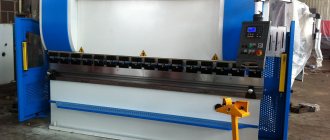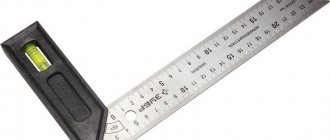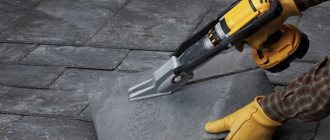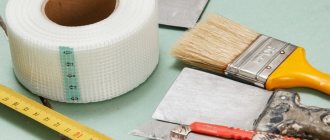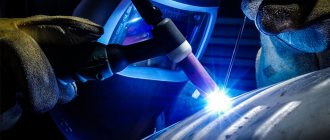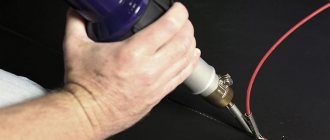Homemade or factory-made welding fixtures hold metal structural components in position and improve positioning accuracy. Equipment is necessary when performing basic and additional steps of the technological process. In serial or mass production, automatic devices are used. In domestic conditions, mechanically driven products are used.
Welding fixtures are needed to provide the most favorable working conditions.
Types of welding equipment
When carrying out welding work, a transformer or inverter is required, connected to an alternating current network with a voltage of 220 or 380 V.
Since the parts are displaced during the joining process and heated to temperatures above +200°C, equipment is required to position and hold the workpieces. Assistive devices are usually divided into categories based on functionality, performance and principle of operation.
By functionality
Equipment can be:
- Universal, designed to work with workpieces of different designs or geometric configurations. It is characterized by reduced dimensions and weight, and is used when checking the correctness of assembly and installation dimensions, as well as when carrying out repair work. Does not provide high performance. Universal devices include clamps or spring clamps.
- Special, designed to perform one operation or used for welding assemblies with uniform design characteristics. Used in large-scale production, it improves quality and reduces welding time. Special equipment includes assembly and welding stands, jigs or templates.
By type of production
The equipment is divided:
- For serial or mass production. It has an increased service life and ensures faster removal and installation of workpieces. The stops are adjustable for the production of metal structures of various configurations.
- For single or small-scale production. Used at home or for welding experimental units. It is not demanding on the speed of installation or removal of workpieces; it is designed for the production of several dozen welded assemblies.
Equipment is divided by type of production.
By nature of work
Equipment is divided into the following types:
- with a manual drive (for example, with a screw or spring clamp or an eccentric);
- mechanized (with power hydraulic or pneumatic cylinders or electric drives), operating under operator control;
- automated (equipped with a mechanical drive and actuator units, the welder needs to configure the sequence of actions and confirm the start of work).
In addition to equipment that operates at standard speed, there is equipment with increased speed that speeds up technological processes.
For mass production, multi-position or carousel-type equipment is used, which reduces the time for installing and removing workpieces.
Devices can be transported or installed on foundations (rigidly fixed in place or moved along guides).
Sound-absorbing partitions and cabins
Sound-absorbing partitions and cabins are designed for organizing welding, stripping, etc. stations. and protect others from production noise, welding spatter, grinding sparks, etc.
Sound-absorbing partitions and cabins can be used to organize a single workplace, as well as to delimit the entire workshop into separate sections.
The range of noise-absorbing partitions is quite wide.
Simple noise-absorbing partitions make it easy to limit a temporary workplace or get a separate welder’s cabin, which is easy to assemble/disassemble and install in a new location.
Modular noise-absorbing partitions offered by industry today make it easy to get a separate welder’s cabin, increase the area of an existing cabin, or create a complex of cabins. All elements are easy to assemble/disassemble and install in a new location.
Equipment requirements
The equipment used when welding parts must provide:
- Changing the position of the part within the welded unit without the adjustment operation.
- Fast and reliable placement of workpieces in fixtures.
- Maintaining assembly accuracy within the tolerances specified in the design documentation.
- Unobstructed access to welds and parts connection lines.
- Compliance with the dimensions between the ends of the elements being welded.
- Work safety. The equipment is made from materials that are resistant to high temperatures; the application of flammable coatings is not permitted.
- Welding in the lower position to prevent the melt from flowing out of the bath.
- Accelerated heat removal from the working area.
- Protection of moving elements and actuator cylinders from splashes of molten metal and flux.
- Reduced deformation in welding seams.
- Possibility of automating the technological process or mechanizing the transportation of blanks or finished products.
The equipment ensures a change in the position of the part within the welded unit.
Assembly and welding devices
They are divided into the following categories:
- Installation, allowing the positioning of parts in accordance with the drawing documentation. Depending on the configuration of the workpieces, the products have vertical, horizontal or inclined edges. The devices are rigidly attached to the base, moved along guide grooves or tilted to the side on an axis or hinges. Permanent profile stops are welded or screwed to the welding table. Adjustable brackets are used for parts with uneven geometry.
- Fixing or fastening devices that prevent parts from moving during the welding process (for example, due to temperature deformation or accidental exposure to the electrode). Welders use clamps with a lead screw or cam mechanism. To assemble a metal structure, you must have a set of clamping devices (the size of the pharynx is determined by the dimensions of the workpieces).
Ties
The coupler is a threaded bushing that allows you to adjust the distance between the mating edges. To install a bolt, brackets with nuts or holes with threads inside are temporarily installed on the parts.
Recommended reading: Choosing a chameleon mask
For example, a welding square is used when connecting pipes made of carbon steel. There are couplers with clamps that are placed on the outer surface of cylindrical parts and secured with screws. The design does not provide rigid fastening of the parts to be connected.
Tacks
A clamp is a small piece of reinforcement or steel profile that is used to temporarily connect large parts.
To change the position of the parts, adjustable elements (with a threaded bushing) are used.
After filling the joint with molten metal, the clamps are cut off or integrated into the structure of the seam.
Jacks and spacers
Rack jacks and rods with a screw section are necessary for holding metal structural elements with a closed profile and for aligning the mating edges of cylindrical workpieces.
The devices are used to straighten dents on the surface. When connecting pipes, spacers are used in conjunction with external clamping rings, which increases the accuracy of the joints.
Jacks can be equipped with a mechanical drive.
There are products with hydraulic or pneumatic cylinders connected to an external pump or compressor station.
Centralizers
If, when welding workpieces that have an axis of rotation, it is necessary to hold the parts in 3 planes, then centralizers are used. They allow you to align the outer surfaces and the center line.
Workpieces are held by gripping the outer or inner parts. The equipment has a mechanical drive of the executive body. Centralizers for large-sized pipes are equipped with hydraulic cylinders.
Brief description of the operation of the centralizer TsNG-1120:
- Align adjacent sections of the pipeline.
- Place a double roller chain on the joint line.
- Connect the hydraulic drive to an external pumping station with a spool valve.
- Turn on the fluid supply and wait for the outer edges to align evenly.
- Weld the seam through the gap between the chain sections.
- Release the force and then move the device to the next joint line.
Centralizers hold parts in 3 planes.
Making a clamp
Without a clamp, which you can make yourself, no welder will be able to cope with the job. In addition, this tool helps solve problems during plumbing and carpentry work. This device can have different options - specialized and universal. Recently, another modification has appeared, which is a quick-release clamp. With its help, you can provide a compression force of up to 450 kg. However, the main task of such tools is to fix the workpieces for interconnection.
Stands for welding and assembly
Several types of stands are used to connect parts:
- flat slabs;
- racking systems for the production of volumetric metal structures;
- conductors and templates;
- devices for holding parts in the required position during welding.
Shelving and slabs
To connect flat workpieces, plates assembled from sections of steel profile are used. The top edge of the guides forms a flat surface. The parts are fixed using replaceable or rigidly attached stops to the base.
Equipment is divided into stationary, portable and overhead (installed on work tables or beds). The rack is distinguished by the use of inclined surfaces with replaceable supports. It is made of a steel profile that allows you to connect power from a welding transformer.
Algorithm for using a rack when welding a T-shaped beam from flat workpieces:
- Place the stops in the required position and install the elements at the required angle.
- Go through the joint line with a welding tractor or semi-automatic machine.
- Turn the structure over and sew the seam on the other side.
Conductors
The device consists of a frame (with stops and fasteners) mounted on a swinging axis. The jig allows you to install parts in the required position.
The operator then welds the metal structure, changing the installation angle. A device is provided to hold a bath of molten metal and flux in the work area. This allows you to get a strong seam without tears or internal voids.
Adjustable stops are used on the conductors; it is possible to use a welding tractor to automate the assembly process.
In this case, auxiliary components should not interfere with the movement of the equipment.
The tilt angle can be changed manually or electrically. The equipment is used in the serial production of welded structures. In artisanal conditions, conductors are rare.
Fasteners
To firmly hold metal structure parts in a given position, removable or stationary clamps are used, which have different configurations and methods of attachment to the desktop.
Clamps are needed to firmly hold parts.
For example, in the manufacture of products, removable brackets are used to take into account differences in the geometric dimensions of the workpieces.
To connect parts to machined surfaces, rigidly fixed or adjustable prisms are used, and for mass production, a reusable template is installed on the table, defining the outline of the welded structure.
Templates
They are rigidly installed guides that hold several parts in the required position. After welding, the resulting assembly is removed for machining or installation of additional elements using other equipment. Since the cost of manufacturing a template is higher than that of adjustable stops, the technology is used in mass production or for welding individual non-standard structures (the price of the equipment is included in the price of the product).
Stops
Folding or fixed stops keep parts from moving to the side; units are used in jigs and on shelving. Stops are usually divided into limiting (or force) and guides (they do not experience load from the weight of the parts). The brackets are installed with screws (with the ability to move along grooves cut in the base) or welded to the rack.
Stops keep parts from moving.
Clamps
Pressure plates are designed to hold flat or shaped workpieces and have a mechanical or power drive (hydraulic, electromagnetic or pneumatic).
We recommend reading: How to choose a gasoline welding generator
The manual device consists of a bracket (welded to the base or moving along a guide slot) and a screw with a handle. After installing the workpieces, the operator tightens the clamp and begins welding.
Devices with a spring-loaded rod or with a rotating eccentric head mounted on a bracket have become widespread.
Making a welding jig
If you need hand tools for welding, you can start making a jig. It is used when making frames and complex patterns. The design has cone-shaped supports that must be placed on the sides. A rotating plane is attached between them. It should have adjustable longitudinal beams with several screw clamps.
There will be holes in the beams, which is why clamps can be installed along the entire length, which will depend on the size of the product. The width of the assembled structure can be adjusted by introducing beams and spreading them apart. The sliding mechanisms of the described device can be used as a universal means for welding small and large products. If you decide to use stainless steel, then when working it is important to avoid scratches that may occur from screw clamps. That is why the latter should be supplemented with felt stickers that are installed on the lips. Such a device can be assembled from a profile pipe; you will need long bolts and bearings, the penultimate of which are needed for fastening the moving parts.
Equipment for installations
Welding installations use additional technological equipment:
- Baths for holding molten flux, preventing the penetration of foreign impurities into the metal, reducing the strength of the joint. Used when it is impossible to protect the weld using standard methods. For example, when welding vertical sheets with an overlap, a corner is installed that does not allow liquid flux to flow down the surface. Baths can be mobile or stationary.
- Flux pads that prevent molten metal from flowing out through the gap between the sheets. The protective layer is pressed against the lower edge of the workpiece, holds the weld pool and forms a reverse seam bead.
Laying and edging of products
When welding large-sized workpieces, it becomes necessary to rotate and move the assembled unit. There are roller-type and lantern-type tilters.
There are installations with levers or chain grips. The parts are fixed in a given position using manual or mechanical drives, after which the operator begins to weld the seams.
The equipment is equipped with fixed or adjustable stops and clamps, and universal manipulators are produced that allow you to work with workpieces of different sizes.
Roller beds
Roller machines are designed for welding cylindrical elements. The wheels are equipped with a rubberized rim to improve contact. One of the rollers is power driven by an electric motor or manual gearbox; the remaining supports are necessary for positioning the parts in space.
Roller beds are designed for welding cylindrical parts.
To connect conical blanks, the bases of the rollers are equipped with regulators necessary to change the angle of the wheels.
Rotators for products
A rotator (or carousel) consists of a work table with a vertical, inclined or horizontal axis that does not change its position in space. The workpieces are mounted on the surface using clamps; the rotation speed depends on the welding speed and the characteristics of the technological process. To drive the rotary unit, electric motors with gearboxes and hydraulic motors are used (rotation speed depends on fluid pressure).
Universal manipulators
To position welded structures in the industrial cycle, universal stationary equipment is used, equipped with a cast or welded frame with rigid attachment to the foundation slab. Inside the frame there are electric drives, a transformer and mechanisms for supplying inert gas and filler wire. The workpieces are placed on a work table or faceplate with dovetail grooves intended for mounting stops or clamps.
Universal manipulators are used to position welded structures.
The faceplate is equipped with sectors with gear rims and is mounted on a hinge that allows table deflection. Some manipulators are equipped with a surface height adjustment system. There are budget manipulators with manual control used for small-scale production.
Positioners for edging
Designed to rotate installed workpieces into a position that provides access for the electrode or welding head to the joint line. The equipment consists of a frame and a manipulator with a manual, electric or hydraulic drive. The parts are mounted on the surface of a faceplate, which can be rotated in several directions (manually or according to a stored program).
A standard positioner can move the weld assembly around an axis to weld parts along the top and bottom surfaces, and also raise and lower the product to fill joints on the sides with metal. Manual units are equipped with gearboxes with stoppers that reduce the load on the operator during operation. When the mass of workpieces is more than 1500 kg, an electric drive with a constant speed of movement is used (no movement speed controllers are provided; the seam is performed by moving the electrode or head along the line of connection of the parts).
Work methodology
When making the above-described welding device with your own hands, you must weld pipes 15 and 20 cm long onto the square. They must be installed in the corners so that the ends of the pipes are on different sides of the square. Now you can start making auxiliary parts. To do this, a figure in the shape of the letter P is prepared from a pipe; its length should be 10 cm. The second part is made from the same pipes, but the elements are welded together in the form of an isosceles trapezoid.
An isosceles triangle is made on the sides of a square. A U-shaped figure is welded to it, in which a hole is first made in the center for a small bolt. A 4cm bolt should fit into the gap between the figure and the square. A handle is attached to the latter; a nut with a hole can act as it. The small cylinder needs to be threaded for small bolts. It is done along the end of a large bolt. At the point of intersection of the trapezoid's diagonals, holes must be made in both parts. A cylindrical element will be installed between them, in which the thread is first made.
Devices for rotation and fastening of equipment
In automatic or semi-automatic welding, special installations are used that allow the head with the electrode to be moved vertically or horizontally. The equipment consists of a rack and boom that are adjustable in size, and there are points for attaching power cables and hoses for supplying inert gas. The welding tractor moves along the surface of the parts to be joined in accordance with the program, but special trays or brackets are provided to hold the electrical wiring.
When welding, the head with the electrode moves automatically.
Work area equipment
Depends on the nature of the welding work performed and the size of the workpieces. For example, when welding large structures, knee lifts with a cradle for the operator and equipment are used. The units can move along guides or along the ground surface; for control, there is a remote control in the basket.
The drives are equipped with AC motors, some of the actuators are equipped with pneumatic or hydraulic cylinders.
In domestic conditions, a metal table is required, equipped with screens to protect against hot drops of metal and slag. They provide a chair for the welder and a set of devices for fixing parts. Work on flammable floor coverings is not permitted. The walls of the room are painted with light gray materials (to absorb the ultraviolet spectrum). Above the table there are lamps (lighting level from 80 Lux) and a hood with an electric fan (capacity 40 m³/hour).
We recommend reading: How to make an oscillator yourself
Return terminals (ground terminals)
When connecting the power source to the welding circuit, you should pay attention to the quality of the electrical contacts at the output terminals of the device and at the points where the product and electrode are connected.
The return wire, i.e. the wire connecting the product or fixture being welded to the power source, may be less flexible and is usually made from cheaper wire of the PRG, PRN brand (GOST 1977-68). The return wire is often equipped with a quick-release clamp (terminal) of electrically conductive metal for connection to the work being welded.
Wire clamps can be spring type (Figure 43) or screw type with notches for reliable electrical contact even in cases where the metal is not completely clean. It is advisable to provide the possibility of supplying current through both jaws of the clamp. Often, when working in stationary conditions, the return wire is replaced with a copper, aluminum or steel busbar. The cross-section of a steel busbar should be increased compared to copper, since the resistivity of steel is much greater. In addition, when welding with alternating current, additional losses associated with the surface effect are taken into account, i.e., with the phenomenon of uneven current density in conductors (an increase in current density at the periphery and a decrease inside the conductor).
Figure 43 - Spring type clamps
The clamps provide excellent contact with the product, are reliable and durable, and are designed for use in welding with currents up to 150 - 200 and 300 - 400 A.
Clamp terminals (Figure 44) and magnetic terminals (Figure 45) are also produced.
Figure 44 — Clamp terminal
Figure 45 — Magnetic terminal
Welding wire connectors. Special connectors are used to connect welding wires (cables). An example is the one-piece cable connectors SKN-25 (250A), SKN-31 (315A) and SKN-50 (500 A) with a screw connection with rare cable disconnection. Manufactured in climatic version U placement category 1 according to GOST 15150 (Figure 46).
Detachable connectors of the SKR type (Figure 47) require frequent disconnection.
One-piece cable connectors SKNP and detachable panel connectors SKRP (Figure 48) can be mounted on a rigid base.
Figure 46 — One-piece cable connector SKN
Figure 47 — Detachable cable connector type SKR
Figure 48 — SKNP one-piece panel cable connector (a) and SKRP detachable panel cable connector (b)
Pipe welding devices
Pipeline welding equipment ensures the centering of mating products and maintains a uniform gap between the edges. There are devices for straight lines and corner branches. The design of the product includes clamps and additional clamps installed on movable rods or chains.
There are special devices for welding pipelines.
For example, to use a simple straight pipe device, the welder must:
- Move the workpieces with pre-prepared edges.
- Place clamps on the outer parts of the pipes and tighten the screws.
- Adjust the gap by rotating the bolt connecting the brackets to the clamps.
- Fill the joint with molten metal, and then remove the equipment and clean the surface of the joint from scale and slag.
Magnetic devices
For household and industrial welding, assembly and welding fixtures with permanent magnets are often used. For example, there are templates with surfaces located at different angles (fixed or variable). The products allow you to position sections of profile pipes or connect sheet steel workpieces. Magnetic clamps are not used when welding parts made of stainless steel or non-ferrous metals.
Universal equipment from MagTab or V-Pads is equipped with several surfaces with the ability to smoothly adjust their relative position. The operator needs to attach the product to the surfaces of the parts, ensure correct positioning, and then begin welding.
Equipment allows you to reduce the time spent on work and improve quality. The strength of the magnets ensures the immobility of the connected elements.
Working on an angle clamp: preparation
Welding devices are offered for sale today in a wide range, but you can make an angle clamp yourself. The tools and materials for carrying out the work are:
- steel corner;
- threaded studs;
- nuts;
- drill;
- steel plates;
- rods for gates;
- welding machine;
- tap.
Auxiliary Tools
When welding parts, additional tools will be required:
- Hammers with a special striker and brushes with metal bristles, used to remove slag from the surface of the weld. To remove large fragments of flux and remove excess metal, use chisels.
- A measuring tool (square, tape measure, caliper) necessary for transferring drawing dimensions to workpieces. Lines are drawn with a marker, lump chalk or a metal rod with a pointed tip.
- Angle grinder with a protective casing and a set of discs for cutting metal, used when cutting workpieces. A hacksaw is used to cut profiles with a small cross-section. An electrically driven abrasive tool is used to clean edges before welding, as well as seams.
Wire brushes are used to remove slag.
Electrode holders
To make a homemade electrode holder, you need to take three pieces of wire, ten centimeters each, with a diameter of eight millimeters. Bend two of them sideways (it looks like a fork) so that the parts of the wire are directed in opposite directions (left and right). The remaining wire should be located between them, bent towards the top from the side of the connection with the metal rod, up to approximately 0.5 of its length. First of all, the side parts are tacked by welding, then the central part is applied, then everything is finally welded. You may need to add additional wrapping to the wire to keep it from overheating.
What devices are used for home welding?
In domestic conditions, inverters and compact equipment with a welding torch and an inert gas supply system are used. The master needs to purchase a protective mask, mittens and clothing that protects the skin from burns. To remove scale, you will need a hammer and a metal brush; to fix the parts, use a magnetic square with adjustable edges (ranging from 30° to 135°). The equipment is selected according to the power of the magnets. For domestic purposes, a force of 8-12 kg is sufficient; for large workpieces, a device with a force of 30-35 kg will be required.
Clamps, universal clamps with a manual drive, are suitable for household use; they allow you to secure metal structural elements in the required position and reduce the deformation of parts during heating and cooling. If you plan to connect metal pipes, then centralizers with a clamp (for example, SM-151 or TsSZ) are used at home.
Is it possible to make something with your own hands?
The welder can assemble auxiliary equipment with his own hands, using available materials. For example, homemade devices for welding pipes are assembled from scraps of corners and clamps for carpentry or plumbing. Installing the stops at right angles allows you to assemble a simple jig for making a batch of welded structures (frames for installing grilles in windows or making fence sections).
A brief algorithm for manufacturing the simplest equipment for welding:
- Cut rectangular blanks from scrap profiles or sheets 5-10 mm thick using an abrasive tool.
- Process the edges manually or on a milling machine, remove traces of paint and corrosion from the surfaces.
- Attach the stops to the base (for example, to a metal workbench or channel rack), taking into account the relative position of the parts.
To make a magnetic stop, you need to cut out 2 symmetrical templates, which are attached to the sides of the magnet with a central hole with bolts. The location of the screws does not allow the plates to move relative to each other. The emphasis is placed on the first part, and the second element is placed along the side surface of the template. Then the components are connected by several welding points, the stop is removed and the seam is completely welded on both sides.
There are homemade templates cut from a steel plate with subsequent processing of the edges on a milling machine. The workpiece is placed on the base and additional stops are installed to limit mobility. Welders use makeshift clamps made from profile scraps and bolts with nuts. There is no single standard for homemade equipment; each master develops devices, focusing on experience and taking into account the specifics of the work performed.
Non-consumable electrode welding
The apparatus for connecting metal wires, twisting or making thermocouples is often made independently with your own hands. But it should be borne in mind that the price of a finished product purchased in a store may be lower than the total amount of all components if you buy them. However, as a rule, parts can also be found at dismantling sites, and, perhaps, they can be obtained by disassembling old equipment.
To manufacture the device, you will need one 20-50 V transformer, four connecting wires (two for connection, for connecting the electrode and connecting to the network). The electrode can be graphite, which can be easily obtained by removing the lead from a pencil. Anything you can adapt for this purpose will serve as a holder.
The assembly of such devices occurs according to a standard scheme, which can be easily found in many sources and, by and large, consists of correctly connecting the wires and packing it all into the case.

